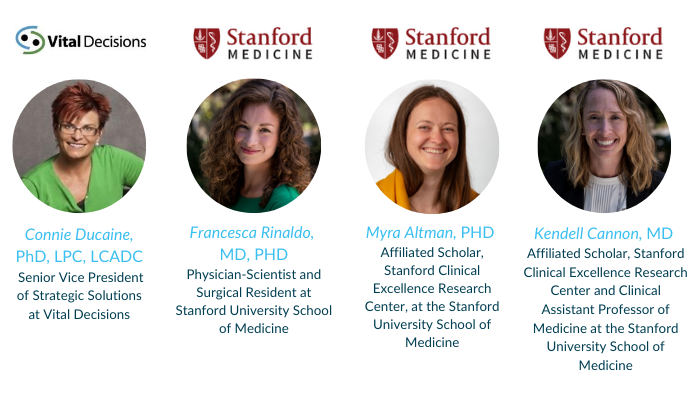for
Individuals
Better Quality of Life
Learn More
Resource

A late-life care research team with Stanford’s Clinical Excellence Research Center (CERC) presents 3 interventions that redefine late-life care — and challenge us to redefine what constitutes healthcare.
While the challenges that older Americans face are well known, the researchers sought to find innovative and scalable care models that address the root problems — felt by patients, caregivers and providers alike.
At the core, the researchers prioritized programs that share a common philosophy:
Recently, we presented a webinar on “Optimizing Late-Life Care and Spend” with the Stanford researchers Francesca Rinaldo MD, Myra Altman PhD, and Kendell Cannon MD, moderated by our own Connie Ducaine.
The webinar is now available on-demand, and here are the highlights of the conversation:
Francesca Rinaldo: We come from different clinical backgrounds — surgeon, an internist, a psychologist. We all see the admissions to the emergency room and ICU and ask ‘what are we missing as the root causes?’
Our conceptual approach looked at 3 phases of late-life experience:
Interviews — with all stakeholders in care delivery — were key to this research, to get to the heart of what individuals need and why.

While shadowing a visiting nurse, Myra asked an elder about the visiting nurse who visits her weekly. She described the nurse as “a good friend”, highlighting the minimal social contact the older person had.

AgeWell employs older high-functioning adults to visit chronically ill and socially isolated seniors to provide companionship and screen for unmet medical needs and refer them to appropriate services. It is deployed as a post hospital discharge service.
Francesca Rinaldo: What if you could reduce 30-day hospital readmission by 25%” for an intervention cost. There’s another program that reported 30-day readmissions by 82%. There is a significant range of impact.
Kendell Cannon: As people’s functional capabilities decline, we saw dramatically increased utilization and poor quality of life.
As it gets increasingly difficult for older adults to live at home as their functional capabilities decline, the Capable model piloted out of Johns Hopkins School of Nursing identifies the “minimum viable interdisciplinary team” of a nurse, a home repair specialist, and an occupational therapist. The team makes home modifications to enable safer aging in place.

Ideal target population for the intervention has greater than 3 chronic conditions and functional limitations. The cost of the intervention delivers benefits that compounded for 2 years following the intervention.
Myra Altman: Misaligned care happens when an individual has a desire for what they want their care to be but they get something very different — particularly true at end-of-life when people do not want to die in a hospital, yet a majority do.
The disconnect is huge:
What gets in the way of having the conversation? Providers are often reluctant to start the conversation because they don’t want to remove hope, especially when the prognosis is unsure. Also these conversations take time that providers just don’t have.
But patients are waiting for their providers to initiate the conversation.
Vital Decisions’ Living Well program is an intervention model where a behavioral health specialist makes a call to activate and empower patients. It’s scalable and translatable.

Connie Ducaine: If you’re patient-centric, you must use motivational interviewing…to find their “why”. When we find our own “why” we are much more inclined to do something. A specialist will unpack their priorities, preferences, values so that the patient knows “What do I want, who do I need to tell?”
A lot of people now use motivational interviewing — which is great because when we integrate with a provider or a health plan, then we’re speaking the same language.

Click on the logos below to learn more about each of the three solutions featured in this research:
Questions about the research or about Vital Decisions? Reach out to us at info@vitaldecisions.net. We’d love to hear from you.